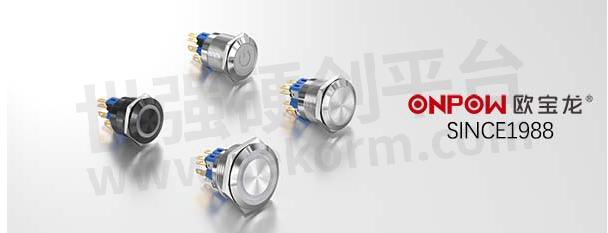Push Button Switches: Working Principles and Differences between Latching & Momentary

As a component of user interface design, Push Button Switches play an important role in our daily life. But have you ever wondered how exactly a push button switch works? And what’s the difference between latching and momentary push button switches? In this article, ONPOW will provide a detailed introduction.
Firstly, let us explain how a push button switch works. A push button switch is an electrical switch that is typically used to control a circuit, which consists of two parts: a contact and an actuator. The contact is a conductive metal piece that makes a connection with another contact once it is pressed by the actuator. The actuator is usually a plastic button that is connected to the contact; when it is pressed, it pushes down the contact and creates a short circuit between the two contacts.
Now let’s talk about latching and momentary push button switches. A latching switch, also known as a “self-locking switch,” is a type of switch that maintains its position even after you release it. It will remain in either the open or closed position until it is manually toggled again. Examples of latching push button switches include toggle switches, rocker switches, and push-button switches. These switches are often used in situations where the circuit needs to be turned on or off and stay in that state for a prolonged period.
On the other hand, a momentary switch, also known as a “momentary contact switch,” is a type of switch that only maintains its position while it is being pressed or held down. As soon as you release the push button switch, it springs back to its original position and breaks the circuit. Examples of momentary push button switches include push-button switches, rotary switches, and key switches. These switches are often used in situations where the circuit only needs to be turned on or off for a brief moment.
In conclusion, push button switches are an essential part of modern user interfaces, and understanding how they work can help us design better products. By knowing the differences between latching and momentary push button switches, we can choose the right type of switch for our specific application.

- +1 Like
- Add to Favorites
Recommend
- Enhance the Style of Your Interior with Trendy Push Button Switches
- Versatility and Efficiency of Push Button Switches in Modern Products
- The Ultimate Guide to Push Button Switches in the Building and Decorative Materials Industry
- Exploring the Different Types of Push Button Switches for Interior Design
- Why Push Button Switches Are the Perfect Choice for Modern Architecture?
- ONPOW Push Button Switches: Customizable and Reliable Solutions for Automotive and Industrial Needs
- Essential Features of Push Button Switches in Modern Renewable Energy Systems
- Reliable Door Control with ONPOW’s GQ16 and GQ19 Series Push Button Switches
This document is provided by Sekorm Platform for VIP exclusive service. The copyright is owned by Sekorm. Without authorization, any medias, websites or individual are not allowed to reprint. When authorizing the reprint, the link of www.sekorm.com must be indicated.






























































































































































































































































































































































































































































































































































































































































































































































































































































































